Summary

While space is increasingly crucial to modern society, it is also increasingly hazardous for satellites. Space is congested with tens of thousands of man-made objects as well as micro-meteors, asteroids and other natural satellites. Space is contested by a range of man-made threats that may have adverse effects on satellites.
Current deep space telescopes do not provide a comprehensive picture of all objects in orbit around the Earth. Existing search telescopes have relatively narrow fields of view and cannot reliably detect and track faint objects, including small objects in geosynchronous orbits (roughly 22,000 miles high). There may be as many as hundreds of thousands of additional pieces of debris and asteroids that are too faint to track with current sensors.
The Space Surveillance Telescope program aims to enable ground-based, broad-area search, detection, and tracking of faint objects in deep space for purposes such as space mission assurance and asteroid detection. SST offers improvements in determining the orbits of newly discovered objects and provides rapid observations of events that may only occur over a relatively short period of time, like a supernova. SST’s innovative design allows for a short focal length, wide field of view, and a compact optical train. The SST mirrors are some of the steepest aspherical curvatures ever to be polished and allow the telescope to have the fastest optics of its aperture class. These features combine to provide orders of magnitude improvements in deep space surveillance.
The telescope achieved first light in February 2011. In 2013, the U.S. Secretary of Defense and Australian Minister of Defence signed an MOU agreeing to relocate the Space Surveillance Telescope from the White Sands Missile Range in New Mexico to Harold E. Holt Naval Communication Station in Western Australia. Australia offers a uniquely beneficial vantage point for operational testing and demonstration of SST’s enhanced algorithms and camera. After the move, SST will be owned by the United States Air Force, but operated and maintained by Australia. It will be a dedicated sensor in the U.S. Space Surveillance Network (SSN).
Currently, the SST program is developing enhanced small-object detection algorithms, a new, advanced wide-field camera, and faster search operations in preparation for relocation to Harold E. Holt Naval Communication Station. SST is also leading the community in developing and applying tactical sensor tip-and-cue techniques, as well as applying the vast data archive to refine orbital debris density models. SST has also been prolific at observing asteroids, contributing to the discovery of more than 1,300 new asteroids, and providing more than 5,500,000 asteroid observations to the international community via the International Astronomical Union (IAU) Minor Planet Center. The telescope is also supporting the astronomical community by collecting data on behalf of the Large Synoptic Space Telescope consortium and NASA Orbital Debris Program Office.
Office
Tactical Technology OfficeThis program is now complete.
This content is available for reference purposes. This page is no longer maintained.
